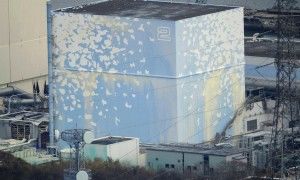
© enformable.comReactor 2, the new problem...
US West Coast being continuously exposed to Fukushima radioactive releases, it's an ongoing tragedy.
Marine Chemist: Impossible to stop nuclear waste flowing into ocean; "It never will be... that's what keeps me up at night."
Radiation levels spiked 1,000% since floods. Up to 100% of No. 2 reactor fuel may have melted. A group of researchers says it is highly likely that
70 to 100 percent of fuel has melted at one of the damaged reactors at the Fukushima Daiichi nuclear power plant. The group includes researchers from Nagoya University. It has been probing the plant's
No. 2 reactor since April of last year, using a device that uses elementary particles called muons to see into its interior.
The researchers say the
results of their study show few signs of nuclear fuel at the reactor core, in contrast to the No. 5 reactor where fuel was clearly visible at its core. This led them to believe that 70 to 100 percent of fuel at the reactor has likely melted. The researchers say further analyses are needed to determine whether molten fuel penetrated the reactor and fell down.
The No. 2 reactor is said to have released large amounts of radioactive substances following the March 2011 accident. Tokyo Electric Power Company, the plant's operator, has estimated that part of nuclear fuel at the reactor remains at its core.
The locations of nuclear fuel will have a significant impact on the process to remove it from the damaged reactors, the most difficult step of the decommissioning work.
Video: Fukushima Daiichi update 0:00 to 8:09
TEPCO was advised on tsunami risk before quakeThe Japanese government has revealed that an official had
advised Tokyo Electric Power Company to implement better tsunami measures 2 years before the 2011 Fukushima Daiichi nuclear accident. Authorities on Thursday released depositions by 5 people who testified before a government investigative panel on the nuclear crisis. They include a former inspector of the now-defunct Nuclear and Industrial Safety Agency.
Initially, in September 2009, the utility told the agency official a tsunami from a possible earthquake could reach as high as 8 meters. An expert from TEPCO used a massive quake from the 9th century as the basis for the estimate.
The agency official then suggested TEPCO to take concrete measures to prepare for a tsunami as he knew the pumps to cool the reactors would be submerged under those circumstances.The inspector reportedly
advised the utility to move the equipment inside buildings, like the Fukushima Daini plant, TEPCO's other nuclear power station in Fukushima Prefecture. The documentation says a TEPCO official responded the utility could not decide by itself and
needed to consult the Japan Society of Civil Engineers.Another TEPCO official cast doubt on the plan by wondering if it's really possible to halt the reactors for that purpose. The inspector further testified he didn't push the plan to the point of earmarking a budget for it. After reviewing the statements,
the government panel decided the agency did not urge TEPCO to take concrete action. It concluded the utility believed the government agency approved of its decision to wait until experts provided advice.
TEPCO to sign cooperation pact with France's CEA Nuclear & EnergyNHK has learned that the operator of the crippled nuclear plant in Fukushima
plans to sign an agreement with a French organization to obtain the necessary technology to decommission the facilities.Tokyo Electric Power Company, or TEPCO, will initially focus on decontaminating the areas around the reactor containment vessels.
The removal of molten nuclear fuel will be the toughest challenge in the decontamination process because of the extremely high radiation levels. TEPCO plans to obtain technical knowhow from CEA, which is funded by the French government. The French organization has expertise in dismantling aged nuclear reactors and fuel-reprocessing facilities.
Sources say that under the agreement,
CEA will help TEPCO to develop remote-controlled robots that can withstand high radiation levels. CEA will also help with training workers and TEPCO will provide data for the decommissioning process.
The agency official then suggested TEPCO to take concrete measures to prepare for a tsunami as he knew the pumps to cool the reactors would be submerged under those circumstances.
Absolutely even more disgusting than the disaster itself..........